Week in the Broughtons
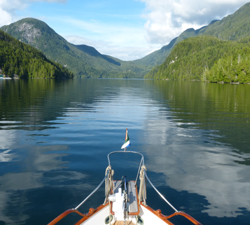
Returning to these waters after many years was both a homecoming…and a tempting taste of cruising adventures to come.
We first visited the Broughtons when friends asked us to deliver their sailboat back to Vancouver after a cruise to Haida Gwaii. From Port McNeill we headed home via Alert Bay, the Indian Islands, Knight Inlet, Lagoon Cove and Johnstone Strait. We never forgot the breathtaking vistas of mountains and channels, the easy hospitality of the marinas, the turquoise water of Knight Inlet, the haunting presence of ancient First Nations inhabitants and more recent pioneers, an exciting sail down Johnstone Strait in a booming westerly – and we couldn’t wait to return in our own boat.
It only took us 16 years!
Life and work kept us closer to home until we traded our sailboat for our Grand Banks 32 trawler Thea, our ticket to extended cruising on the Inside Passage. Our return to the Broughtons last summer proved to be both a long-overdue homecoming and a new beginning.
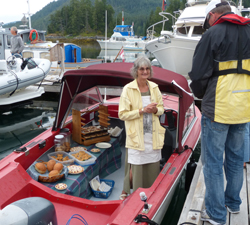 We had three weeks – one week heading north, a week in the waters from Havannah Channel to Queen Charlotte Strait, and a week returning home – an adventure that’s well within reach of any boat with at least trawler speed and range.
We had three weeks – one week heading north, a week in the waters from Havannah Channel to Queen Charlotte Strait, and a week returning home – an adventure that’s well within reach of any boat with at least trawler speed and range.
The Highway
Forward Harbour was our jumping-off point for the run up Johnstone Strait. We had our first clouds and rain since leaving the sunny south, and the morning forecast called for strong westerlies in the strait to ease later on. At dawn the wind at Fanny Island, a rock at the junction of Sunderland Channel and Johnstone Strait, clocked 26 knots so it looked like we might stay put. But by 0900 the breeze was down to 16 knots and we were itching to move.
By the time we reached the “highway” of Johnstone Strait the wind had eased further and our 16-mile run past the strait’s dark, forested slopes to Port Harvey was uneventful. We were free of the rapids and the strait – we had arrived!
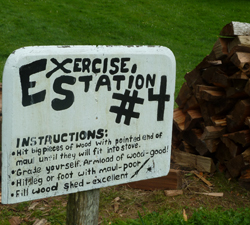 Port Harvey Marina is superbly situated about halfway between Queen Charlotte Strait and Chatham Point, at a natural stopping point on Johnstone Strait and at the entrance to Havannah Channel, the back route to the Broughtons. The marina is a project in progress for its hard-working owners, George and Gail Cambridge, but it has quickly developed a following of cruisers who return regularly, even week after week. The resort building is a former fish-buying barge the Cambridges have converted to hold their office and well-stocked store, washroom and shower, and the licensed Red Shoe Café upstairs.
Port Harvey Marina is superbly situated about halfway between Queen Charlotte Strait and Chatham Point, at a natural stopping point on Johnstone Strait and at the entrance to Havannah Channel, the back route to the Broughtons. The marina is a project in progress for its hard-working owners, George and Gail Cambridge, but it has quickly developed a following of cruisers who return regularly, even week after week. The resort building is a former fish-buying barge the Cambridges have converted to hold their office and well-stocked store, washroom and shower, and the licensed Red Shoe Café upstairs.
The café is a major draw for cruisers in these waters where respite from galley duty is hard to find. Gail took our meal order from their menu after helping us tie up – and our excellent pizza was ready at the appointed time that evening. The café was busy and loud with conversation about the usual topics – destinations, local doings and the weather. We didn’t pass up George’s cinnamon buns the next morning, either.
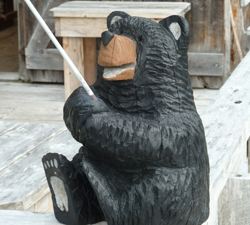 Port Harvey introduced us to the need for coexisting with the wildlife such as bear and cougar that inhabit these islands and the nearby mainland. Knowing that this is their turf can make casual hikes or visits ashore with small dogs like our aging dachshund Rosie unnerving experiences. A mother grizzly bear and her cub had been making their way between Port Harvey and Lagoon Cove for several days, visiting the beaches in both bays. George carried a shotgun for protection as he did chores in the forest behind the marina – but we were advised that an air horn is usually a good deterrent. For bears, that is – but likely not for cougars, much stealthier predators.
Port Harvey introduced us to the need for coexisting with the wildlife such as bear and cougar that inhabit these islands and the nearby mainland. Knowing that this is their turf can make casual hikes or visits ashore with small dogs like our aging dachshund Rosie unnerving experiences. A mother grizzly bear and her cub had been making their way between Port Harvey and Lagoon Cove for several days, visiting the beaches in both bays. George carried a shotgun for protection as he did chores in the forest behind the marina – but we were advised that an air horn is usually a good deterrent. For bears, that is – but likely not for cougars, much stealthier predators.
Our next destination, Lagoon Cove Marina, lies just two miles directly across East Cracroft Island from Port Harvey, but the water route through Havannah and Chatham channels and The Blow Hole is a 12-mile trip. For the first-time visitor, Chatham Channel offers a straightforward lesson in navigating in the waters north of Desolation: clear water good, kelp bad. Beds of bull kelp floating on the surface are clear markers of shoals and shallows – stay away from the kelp and you’ll almost always be perfectly safe. Chatham Channel’s narrowest stretch is clear and bounded by floating kelp so it’s fairly easy to transit.
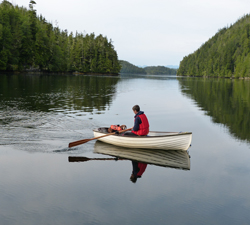 The Blow Hole leads west from Chatham Channel to Lagoon Cove; the marina appears on your left as you pass between Perley Island and the unnamed islet opposite. We called in for a slip – but they had already spotted “the GB just entering the cove.”
The Blow Hole leads west from Chatham Channel to Lagoon Cove; the marina appears on your left as you pass between Perley Island and the unnamed islet opposite. We called in for a slip – but they had already spotted “the GB just entering the cove.”
We’re Baaaack…
Bill Barber, who has operated Lagoon Cove Marina with wife Jean for two decades, helped us tie up, then asked “Is this your first time here?” “No,” I said. “We were here 16 years ago.” “I’m glad you made it back,” he grinned.
Returning to Lagoon Cove was a major milestone for us. We had fine memories of our short stay here, including all the help that came running, cocktails downed, as we prepared to back our borrowed boat into the dock. The marina stands out for the unique personality and sense of fun that is built right into the place. The rustic former boatbuilding shed at the head of the dock is a “historic” workshop; exercise station #4 is the pile of firewood that needs splitting while #6 is a lawnmower; “found” antiques, tools and junk pop up in unlikely spots; and daily happy hours almost always end with one of Bill’s goofy tall tales, delivered utterly deadpan.
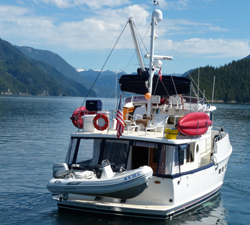 The cruising community in the Broughtons is small and friendships develop easily, especially at the happy hours and potlucks that are part of the entertainment at most marinas. Folks meet over appies, visit boats and share stories, make plans and meet all over again – it’s a sort of floating, roving party.
The cruising community in the Broughtons is small and friendships develop easily, especially at the happy hours and potlucks that are part of the entertainment at most marinas. Folks meet over appies, visit boats and share stories, make plans and meet all over again – it’s a sort of floating, roving party.
But it really was a surprise when Jan literally bumped into an old friend she hadn’t seen in decades in the line for Bill’s endless bucket of local prawns. And wasn’t Leslie and partner PJ’s Selene 43 Moodance moored across the float from us! So a friendship was rekindled: we shared stories and laughs, dinghied around to the ruins of Minstrel Island Resort, and joined a grizzly bear tour to nearby Glendale Cove. And that’s how our one-night stay stretched to three, not unusual here at Lagoon Cove.
“We have to leave – stuff is starting to grow on our bottom,” I told Bill as we paid our tab. We said our goodbyes reluctantly – then made plans to meet Moondance at Kwatsi Bay.
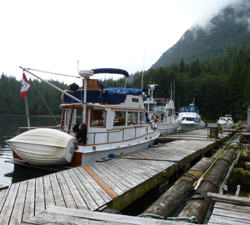 Breathtaking
Breathtaking
Tribune Channel loops north from Knight Inlet, then west to the Broughton Archipelago that gives this region its familiar moniker. It passes several peaks that reach 5,000 feet or more, and a pair of mainland sounds, Thompson and Bond, that cry out for exploring. The slopes bear plenty of evidence of past and recent logging. But boats? Hardly any on our run to Kwatsi Bay, just past the corner where Tribune turns westward.
Kwatsi Bay Marina lies at the head of the bay in a breathtaking natural bowl formed by steep forested walls and broken by a waterfall. To say this is a spectacular setting is an understatement – we felt compelled to lower our voices out of reverence and awe at its beauty. And that was on an overcast day!
Max Knierim, Anca Fraser and their children Marieke and Russell have run the marina since 1998. But after Anca welcomed us, our conversation about life in this otherworldly spot turned to the fact that she and Max are now empty-nesters, their teenagers attending schools on Vancouver Island. Their rustic resort suits its wilderness setting perfectly. The shower is in a simple cabin on the main float; it’s heated by a woodstove and smells of cedar, like a sauna. A picnic shelter protects social gatherings from the weather, and the nearby store offers clothing, souvenirs and crafts by local artists.
The basin’s still water cried out for a row so we splashed our dinghy and took turns touring around the steep shorelines and bluffs. Later, a neighbour told us how surprised and pleased she was to see someone actually rowing! The overcast skies cleared and rainbows arched through the mist as we ooohed and aaahhed before dinner that night on Moondance.
Max stopped by the next morning and, hands hooked in his overalls, offered some local knowledge about nearby anchorages – as well as one or two really good grounding stories! – then helped us on our way. We waved goodbye to Moondance for what we thought was the last time.
Gunkholing
Under sunny skies, we continued west toward the Burdwood Group of islands in search of an extensive midden beach near the centre of this small archipelago. Reaching the beach called for careful gunkholing, so we proceeded slowly and relied on directions in Best Anchorages of the Inside Passage (Anne Vipond and William Kelly). We anchored in a narrow passage directly off the beach and enjoyed a truly perfect afternoon: lunch on the bridge, then a prowl ashore with Rosie.
The exposed Burdwoods are suitable for overnighting only in settled weather. So at Max Knierim’s suggestion, we made our way a few miles north to Simoom Sound and followed its dogleg shape to anchor in O’Brien Bay, near its head. There’s lots of evidence of past logging here, as well as an active logging show. We were joined that evening by two other boats which arranged themselves at a respectful distance, hundreds of yards from us and from each other. If you’ve come all this way, why crowd the neighbours?
But Simoom has a drawback common to many anchorages up here: steep shorelines and difficult access, especially with an elderly dog who is neither as spry or efficient as she once was. We bumped our dinghy into the rock-strewn head of O’Brien Bay for Rosie’s last evening visit ashore, where we spotted fresh bear scat as our beloved dachshund took her sweet time. Spooked and worried that there was no quick escape back over the rocks, we scrambled back into the dinghy and finished our business at a rocky point close to Thea. Dog-friendly, Simoom Sound is not.
On our way the next morning, we spotted a familiar profile approaching from Penphrase Passage. It was Moondance, en route to Port McNeill after a night at Shawl Bay. We gammed and drifted side-by-side in the sunshine until it was time to say our final final goodbye.
We craved one more quiet night at anchor before heading for home, so we bypassed the bright lights of Echo Bay on a Saturday night and nosed our way via Cramer Pass, Blunden Passage and Misty Passage to Joe Cove, on the south side of Eden Island. We were surprised to have this popular anchorage within Broughton Archipelago Marine Park to ourselves, a sign the cruising season was winding down in late August. We basked in the sunshine and savoured the solitude. Dog duty was easier here at a sheltered midden near the cove entrance.
We planned to enjoy this idyllic spot for a second night but the weather north of Desolation is reliably changeable: clouds moved in the next morning and the forecast called for showers. More importantly, strong winds were predicted in Johnstone Strait in two or three days’ time, leaving us a small window for a visit to Sointula on nearby Malcolm Island before we ran south.
We left the Broughtons under a heavy grey sky. Rain squalls loomed over Malcolm Island, and Queen Charlotte Strait lay empty and flat in the haunting silvery light. Outside Arrow Passage, one dark shape broke the surface ahead of Thea, then another: humpback whales cruising across our path. We could hear puffs of breath as they surfaced. One rolled, flicked a long, gnarled flipper into the air, then dove with a toss of its tail.
Beyond them, the empty horizon beckoned – promising us that this wasn’t an ending, but just the beginning of cruising adventures to come.
PHOTO CAPTIONS
Photo 1 – Thea enters a calm Simoom Sound. Duart Snow Photo
Photo 2 – Jenny Rucker, baker and postmaster, sells her wares at Lagoon Cove Marina. Duart Snow Photo
Photo 3 – Lagoon Cove colour. Duart Snow Photo
Photo 4 – Lagoon Cove mascot, nicknamed “Gas Pipe”. Duart Snow Photo
Photo 5 – Joe Cove is a popular anchorage in the Broughton Archipelago but we had it to ourselves. Duart Snow Photo
Photo 6 – Farewell to friends Lesley and PJ on Moondance. Jan Snow Photo
Photo 7 – Kwatsi Bay Marina is a rustic spot in a breathtaking setting. Duart Snow Photo
By Duart Snow




























